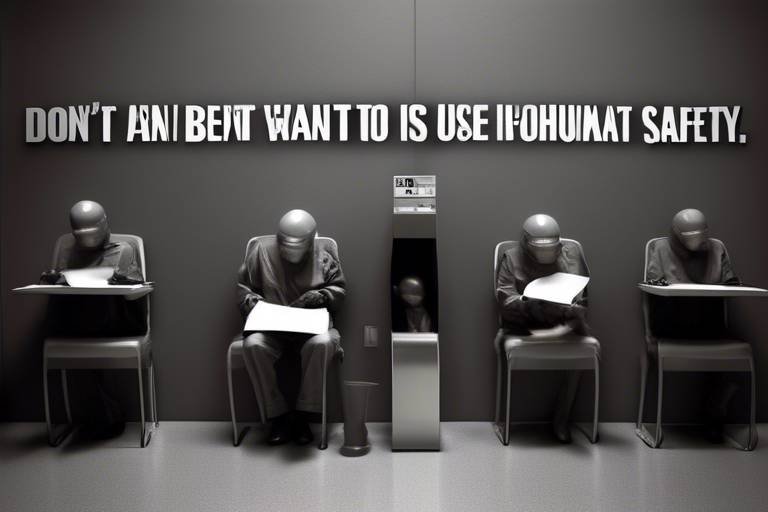How to Implement Safety Measures: The Role of Human Behavior
In today's fast-paced world, the implementation of effective safety measures is more crucial than ever. But here's the kicker: it's not just about the rules and regulations; it's about the people who are expected to follow them. Human behavior plays a pivotal role in the success or failure of safety protocols. Understanding this intersection can lead to a safer environment for everyone. So, how do we ensure that these safety measures are not only in place but also actively embraced by individuals? Let's dive into the fascinating world of human behavior and its impact on safety.
First and foremost, we need to recognize that human psychology is a complex beast. It’s not just about knowing what to do; it’s about the cognitive biases that can cloud judgment and influence decisions. For instance, have you ever noticed how people often underestimate risks? This phenomenon, known as the optimism bias, can lead individuals to disregard safety protocols because they believe "it won't happen to me." Understanding these psychological factors is essential for crafting safety measures that resonate with people on a deeper level.
Another interesting aspect is the decision-making process. When faced with a safety protocol, individuals often weigh the perceived benefits against the effort required to comply. If the effort seems too high or the benefits too low, compliance may falter. Therefore, it’s crucial to design safety measures that are not only effective but also easy to follow. This means simplifying procedures, providing clear instructions, and ensuring that the benefits of compliance are evident and compelling.
Now, let’s talk about the importance of creating a safety culture. A robust safety culture is like a well-oiled machine where everyone is on the same page, committed to prioritizing safety. This culture is built on the foundation of open communication, ongoing training, and strong leadership. When leaders actively participate in safety initiatives, it sends a powerful message: safety is a priority. Employees are more likely to embrace safety measures when they see their leaders walking the talk.
Effective training and education are also vital components of this safety culture. It’s not just about ticking a box; it’s about instilling a genuine awareness of safety practices. Various training methods can be employed to ensure that safety knowledge is not just theoretical but practical and applicable. For instance, hands-on training sessions can help employees understand the importance of safety protocols in real-life scenarios. After all, wouldn’t you agree that learning by doing is often the most impactful way to grasp a concept?
To enhance engagement and retention, organizations can utilize interactive training techniques. Imagine a training session where employees participate in simulations or role-playing exercises that mimic real-life situations. This approach not only makes learning more enjoyable but also reinforces the importance of adhering to safety protocols. When individuals can visualize the consequences of unsafe behaviors, they’re more likely to internalize the lessons learned.
Furthermore, safety training should never be a one-and-done affair. The need for continuous learning and refresher courses cannot be overstated. Just like how we regularly update our software to stay secure, we must also update our safety knowledge. Regular refresher courses keep safety top-of-mind and ensure that employees are aware of the latest protocols and best practices. A culture of continuous improvement in safety knowledge can significantly reduce incidents and enhance overall safety compliance.
Now, let’s shift gears and discuss the role of behavioral interventions. These interventions can be game-changers in promoting safer behaviors. Techniques like nudges, incentives, and feedback mechanisms can encourage individuals to adhere to safety measures more consistently. For example, providing immediate feedback when safety protocols are followed can reinforce positive behaviors, while incentives for compliance can motivate employees to prioritize safety.
Establishing monitoring and feedback systems is also essential for assessing safety behavior. By collecting data on safety practices, organizations can identify areas for improvement and reinforce positive behaviors. This data-driven approach allows for informed decision-making, ensuring that safety measures are effective and relevant. Imagine being able to pinpoint exactly where compliance is lacking and addressing those issues head-on—now that’s powerful!
Lastly, encouraging employee involvement and feedback fosters a sense of ownership over safety practices. When employees feel that their voices are heard and valued, they are more likely to engage in safety initiatives. Methods for soliciting feedback can include surveys, suggestion boxes, or regular safety meetings where employees can share their thoughts and experiences. This collaborative approach not only enhances compliance but also creates a more inclusive safety culture.
- What are the key components of a safety culture? A safety culture includes open communication, ongoing training, leadership involvement, and employee engagement.
- Why is continuous training important? Continuous training keeps safety knowledge current and reinforces the importance of adhering to safety protocols.
- How can behavioral interventions improve safety compliance? Behavioral interventions such as nudges and incentives encourage safer behaviors by making compliance more appealing and rewarding.
- What role does data play in safety measures? Data helps organizations identify trends, assess compliance, and make informed decisions to enhance safety measures.

Understanding Human Behavior in Safety
When it comes to safety, understanding human behavior is like holding the key to a treasure chest. Why? Because our actions, decisions, and even our perceptions play a pivotal role in how we respond to safety measures. Imagine you're driving a car; you know the rules, but how often do you actually follow them? This disconnect between knowledge and action is where psychology steps in. Cognitive biases, such as overconfidence or optimism bias, often lead individuals to underestimate risks, making them less likely to adhere to safety protocols. It’s like walking a tightrope without a safety net—dangerous, yet many do it without a second thought.
Moreover, decision-making processes are influenced by various factors, including emotions, social norms, and past experiences. For instance, if someone has never experienced an accident, they might believe that safety measures are just precautions that don’t apply to them. This illusion of invulnerability can be detrimental. To combat this, organizations must foster an environment where safety is not just a set of rules but a shared value. By understanding these psychological underpinnings, we can tailor safety measures that resonate more effectively with individuals.
Another critical aspect is the environment in which safety measures are implemented. For example, a noisy factory floor might drown out important safety announcements, leading to non-compliance. Therefore, it’s essential to create a setting that promotes awareness and encourages safe behaviors. This could involve clear signage, regular safety drills, and an open dialogue about safety concerns. By addressing environmental factors alongside human psychology, organizations can significantly enhance the effectiveness of their safety protocols.
In summary, understanding human behavior in safety is not just about recognizing the challenges but also about leveraging this knowledge to create effective strategies. By addressing cognitive biases, emotional influences, and environmental factors, we can foster a culture of safety that resonates with individuals on a personal level. After all, when people feel that safety is a collective responsibility, they are more likely to engage actively in maintaining it.

Creating a Safety Culture
Establishing a strong safety culture within an organization is not just a checkbox on a compliance list; it’s the very foundation upon which effective safety practices are built. Imagine a workplace where every individual feels a shared responsibility for safety—where employees actively look out for one another and take pride in maintaining a hazard-free environment. This collective commitment can transform the way safety is perceived and practiced, leading to fewer accidents and a healthier workplace.
To foster such a culture, organizations must emphasize key elements that nurture safety consciousness among employees. One of the most critical components is communication. Open lines of communication ensure that everyone is aware of safety protocols and feels comfortable discussing safety concerns. When employees know they can voice their worries without fear of reprisal, it creates an atmosphere of trust and collaboration.
Furthermore, effective training is essential in embedding safety into the organizational culture. Training should not be a one-time event but an ongoing process that evolves with the workplace. This means regular workshops, refresher courses, and interactive sessions that engage employees actively. When individuals are equipped with the right knowledge and skills, they are more likely to adhere to safety protocols and encourage their peers to do the same.
Leadership involvement is another cornerstone of a robust safety culture. When leaders prioritize safety, it sends a clear message to employees that safety is a top concern. Leaders should lead by example; their actions speak volumes. If management demonstrates a commitment to safety—whether by participating in safety drills or actively engaging in safety discussions—employees are more likely to follow suit. This creates a ripple effect that can permeate throughout the organization.
To encapsulate the essence of a safety culture, consider the following essential elements:
- Open Communication: Encourage employees to share safety concerns and suggestions.
- Ongoing Training: Implement regular training sessions to keep safety knowledge fresh.
- Leadership Commitment: Ensure that management actively participates in safety initiatives.
- Recognition and Rewards: Celebrate safe behaviors and achievements to motivate employees.
By integrating these elements into the workplace, organizations can create a thriving safety culture that not only protects employees but also enhances overall productivity and morale. After all, when employees feel safe, they can focus on their tasks without the burden of worry, leading to greater efficiency and job satisfaction.
- What is a safety culture? A safety culture is an organizational commitment to safety that involves shared values, beliefs, and practices among employees and management.
- How can communication improve safety culture? Open communication allows employees to express concerns and share safety insights, fostering a collaborative environment focused on safety.
- Why is leadership important in creating a safety culture? Leadership sets the tone for safety priorities. When leaders demonstrate commitment to safety, it encourages employees to adopt similar attitudes.

Training and Education
When it comes to implementing effective safety measures, are the cornerstones that cannot be overlooked. Think of safety training as the foundation of a house; without a solid base, everything built on top is at risk of collapsing. Organizations must recognize that simply having safety protocols in place is not enough. Employees need to understand the "why" behind these measures, and this is where comprehensive training programs come into play.
Effective training programs are not just about ticking boxes; they are designed to instill a culture of safety awareness that permeates every level of the organization. For instance, a well-structured training program should encompass various aspects of safety, from recognizing hazards to understanding emergency procedures. This means that training should be tailored to the specific needs of the workplace, ensuring that all employees are equipped with the knowledge and skills necessary to navigate their environment safely.
Moreover, the effectiveness of training can be significantly enhanced through the use of interactive techniques. Traditional lecture-based training often fails to engage participants, leading to a lack of retention and application of knowledge. Instead, incorporating methods such as simulations, role-playing, and hands-on activities can create a more dynamic learning experience. For example, a fire drill simulation can help employees practice evacuation procedures in a safe environment, making them more likely to respond appropriately in a real emergency.
Additionally, it's crucial to recognize that safety training is not a one-time event but an ongoing process. Regular refresher courses should be implemented to keep safety knowledge fresh and relevant. These sessions can serve as a valuable opportunity to update employees on new safety protocols, address any changes in regulations, and reinforce the importance of adhering to safety measures. By fostering a culture of continuous learning, organizations can ensure that safety remains a top priority.
In summary, the role of training and education in safety measures cannot be overstated. By investing in comprehensive, interactive, and ongoing training programs, organizations can cultivate a workforce that is not only knowledgeable about safety protocols but also committed to practicing them. This commitment can significantly reduce the risk of accidents and injuries, ultimately creating a safer work environment for everyone.
- What is the importance of safety training?
Safety training is essential because it equips employees with the knowledge and skills to recognize hazards and respond appropriately, ultimately reducing the likelihood of accidents. - How often should safety training be conducted?
Safety training should be conducted regularly, with refresher courses at least annually or whenever there are significant changes in procedures or regulations. - What are some effective training methods?
Effective training methods include interactive techniques such as simulations, role-playing, and hands-on activities, which enhance engagement and retention.

Interactive Training Techniques
When it comes to safety training, traditional lectures and slideshows can often feel like a chore. Let’s face it—who hasn’t zoned out during a monotonous presentation? That’s where come into play, transforming the learning experience from dull to dynamic. Imagine attending a training session where you’re not just a passive listener but an active participant. This engagement not only enhances retention but also makes the learning process enjoyable. So, what are some of these techniques that can truly make a difference?
One of the most effective methods is simulation training. This involves creating realistic scenarios where employees can practice safety protocols in a controlled environment. For instance, in a construction setting, workers can engage in virtual reality simulations that mimic potential hazards they might face on the job site. This hands-on experience helps them understand the importance of safety measures in a way that theory alone cannot achieve.
Another engaging technique is role-playing. In this approach, participants take on different roles to act out various safety situations. By stepping into someone else’s shoes, they can better appreciate the consequences of unsafe behaviors and the importance of adhering to safety protocols. Imagine a scenario where a worker plays the role of a supervisor who must enforce safety rules while another plays a non-compliant employee. This not only fosters empathy but also encourages open discussions about safety challenges.
Additionally, incorporating hands-on activities can significantly boost engagement. These activities can range from assembling safety gear to conducting mock emergency drills. By actively participating, employees are more likely to remember the procedures and understand their significance. In fact, studies show that people retain more information through action than through passive observation. So, why not turn safety training into a hands-on experience?
Now, let’s consider the impact of technology in enhancing interactive training. With the rise of mobile apps and online platforms, training can be more accessible and flexible. For example, safety apps can provide quizzes, videos, and interactive content that employees can access anytime, anywhere. This not only caters to different learning styles but also allows employees to revisit important safety information as needed. It’s like having a personal safety coach in your pocket!
To wrap it up, the key takeaway is that interactive training techniques are not just a trend; they are a crucial component in developing a safety-conscious workforce. By incorporating simulations, role-playing, hands-on activities, and leveraging technology, organizations can foster an environment where safety is prioritized and understood. So, the next time you’re planning a training session, think outside the box! Your team—and their safety—will thank you.
- What are the benefits of interactive training techniques?
Interactive training techniques enhance engagement, improve retention, and make learning enjoyable. They allow participants to apply knowledge in real-world scenarios. - How can I implement role-playing in safety training?
To implement role-playing, create scenarios relevant to your workplace, assign roles, and encourage participants to act out the situation. Debrief afterward to discuss lessons learned. - Are simulations effective for all types of training?
While simulations are highly effective, their success depends on the context. They work best for environments with high risks, such as construction or healthcare. - How can technology enhance safety training?
Technology can offer flexible, accessible training through apps and online platforms, providing interactive content that caters to different learning styles.

Continuous Learning and Refresher Courses
In the ever-evolving landscape of safety protocols, continuous learning and refresher courses play a pivotal role in ensuring that employees remain vigilant and informed. Think of it like maintaining a car; regular tune-ups and checks are essential to keep it running smoothly and safely. Similarly, in the realm of workplace safety, ongoing education is key to preventing accidents and fostering a culture of safety.
Refresher courses are not just a formality; they are an opportunity to revisit essential safety practices, update knowledge on new regulations, and address any gaps in understanding that may have developed over time. For instance, consider that safety protocols can change due to new technology or updated industry standards. Without regular training, employees might rely on outdated methods that could compromise their safety and that of their colleagues.
Moreover, continuous learning can be tailored to meet the specific needs of an organization. By leveraging various training methods, such as online modules, in-person workshops, and hands-on simulations, companies can create a dynamic learning environment. This approach not only keeps the content fresh but also caters to different learning styles. For example, some employees may benefit from visual aids, while others might prefer interactive discussions or practical demonstrations.
To illustrate the importance of refresher courses, consider the following table that outlines the benefits of continuous learning:
| Benefit | Description |
|---|---|
| Enhanced Knowledge | Regular updates keep employees informed about the latest safety protocols and technologies. |
| Improved Compliance | Frequent training reinforces the importance of adhering to safety measures, leading to better compliance rates. |
| Increased Engagement | Interactive and varied training methods help maintain interest and engagement among employees. |
| Better Retention | Ongoing education aids in solidifying knowledge, making it easier for employees to recall safety practices when needed. |
Additionally, refresher courses can serve as a platform for employees to share their experiences and insights regarding safety practices. This open dialogue can lead to valuable feedback that helps organizations refine their safety protocols. When employees feel they have a voice in the process, they are more likely to take ownership of their safety responsibilities.
In conclusion, continuous learning and refresher courses are not merely checkboxes on a compliance list; they are vital components of a comprehensive safety strategy. By investing in regular training, organizations can cultivate a workforce that is not only knowledgeable but also committed to maintaining a safe working environment. After all, safety is a shared responsibility, and through ongoing education, everyone can contribute to a culture of safety that protects both individuals and the organization as a whole.
- Why are refresher courses important? Refresher courses ensure that employees stay updated on the latest safety protocols and practices, reducing the risk of accidents.
- How often should refresher courses be conducted? It is recommended to conduct refresher courses at least annually, but the frequency can vary based on the industry and specific safety needs.
- What are some effective training methods for continuous learning? Effective methods include online training modules, in-person workshops, hands-on simulations, and interactive discussions.
- How can organizations encourage participation in refresher courses? Organizations can encourage participation by highlighting the benefits of training, offering incentives, and creating a culture that values safety and learning.

Behavioral Interventions
When it comes to enhancing safety compliance, can be a game changer. Think of them as the gentle nudges that guide individuals toward safer practices without being overly forceful. These interventions are based on the understanding that human behavior can be influenced in subtle yet effective ways. By employing various strategies, organizations can create an environment where safety becomes second nature. But how do we achieve this?
One effective method is the use of nudges. A nudge is a small change in the environment that makes it easier for people to make safe choices. For instance, placing hand sanitizers in visible locations or marking pathways clearly can prompt individuals to follow safety protocols without them even realizing it. This approach leverages the power of cognitive biases, guiding people towards the desired behavior while making it feel effortless.
In addition to nudges, incentives play a crucial role in promoting safer behaviors. Imagine a workplace where employees are rewarded for adhering to safety practices. This could be in the form of recognition, bonuses, or even simple shout-outs during meetings. Such incentives not only motivate individuals but also foster a sense of community around safety. When people feel appreciated for their efforts, they are more likely to continue engaging in safe practices.
Furthermore, implementing feedback mechanisms is essential in behavioral interventions. Regular feedback provides individuals with insights on their performance and areas for improvement. For example, a safety app that tracks compliance and offers real-time feedback can significantly enhance awareness and adherence to safety protocols. This ongoing dialogue between employees and management creates a culture of accountability and continuous improvement.
To illustrate the effectiveness of these strategies, consider the following table that summarizes various behavioral interventions and their impacts:
| Intervention Type | Description | Impact on Safety |
|---|---|---|
| Nudges | Subtle environmental changes to encourage safe choices | Increased compliance with safety protocols |
| Incentives | Rewards for adhering to safety practices | Enhanced motivation and engagement |
| Feedback Mechanisms | Regular performance insights and improvement suggestions | Increased accountability and knowledge retention |
In conclusion, the implementation of behavioral interventions is not just about enforcing rules; it’s about creating an environment where safety is prioritized and valued. By understanding the psychological factors that influence behavior, organizations can craft strategies that resonate with individuals on a deeper level. Whether through nudges, incentives, or feedback, the goal remains the same: to cultivate a culture of safety that everyone can embrace.
- What are behavioral interventions? Behavioral interventions are strategies designed to influence individuals' actions toward safer practices through subtle changes in their environment or incentives.
- How do nudges work? Nudges work by altering the way choices are presented, making it easier for individuals to make safe decisions without restricting their freedom of choice.
- Can incentives really improve safety compliance? Yes, incentives can motivate individuals to adhere to safety practices by providing recognition or rewards, fostering a positive culture around safety.
- Why is feedback important in safety practices? Feedback is crucial as it helps individuals understand their performance, encourages accountability, and promotes continuous improvement in safety behaviors.

Monitoring and Feedback Systems
When it comes to ensuring safety in any environment, play a pivotal role. Imagine a ship sailing through turbulent waters; without a reliable navigation system, it would be easy to veer off course. Similarly, organizations must establish robust systems to assess safety behaviors and compliance effectively. These systems not only provide insights into how safety protocols are being followed but also highlight areas that need improvement.
One of the primary functions of monitoring systems is to collect data on safety practices. This data can be gathered through various means, including surveys, incident reports, and observational studies. By regularly reviewing this information, organizations can identify trends and patterns that may indicate potential risks or areas of non-compliance. For instance, if data shows a consistent increase in near-miss incidents in a particular department, it raises a red flag that something needs to be addressed.
Moreover, feedback mechanisms are crucial in reinforcing positive behaviors and correcting unsafe practices. When employees receive timely and constructive feedback, it fosters a culture of continuous improvement. Consider implementing a system where employees can report safety concerns anonymously. This not only empowers workers to speak up but also provides management with valuable insights into the safety climate of the organization.
To illustrate the effectiveness of these systems, let’s take a look at a simple table that outlines the benefits of monitoring and feedback systems:
| Benefit | Description |
|---|---|
| Identifies Risks | Allows organizations to pinpoint areas of concern before they lead to incidents. |
| Encourages Accountability | Promotes a sense of responsibility among employees regarding safety practices. |
| Enhances Communication | Facilitates open dialogue about safety issues, leading to collaborative solutions. |
| Drives Continuous Improvement | Encourages organizations to refine their safety protocols based on real-world data. |
In addition to data collection and feedback, it’s essential to establish a clear process for how this information is utilized. For instance, regular safety meetings can be a platform for discussing findings from monitoring systems. These meetings should not only focus on problems but also celebrate successes. Recognizing employees who consistently adhere to safety protocols can motivate others to follow suit.
Furthermore, leveraging technology can enhance monitoring and feedback systems significantly. With the advent of wearable technology and mobile apps, organizations can track safety compliance in real-time. Imagine a construction site where workers wear smart helmets that monitor their environment for hazards. The data collected can be analyzed instantly, allowing for immediate corrective actions. This proactive approach not only keeps employees safe but also minimizes the risk of costly accidents.
In conclusion, effective monitoring and feedback systems are integral to promoting a culture of safety within an organization. By collecting data, providing feedback, and utilizing technology, organizations can create a safer environment for everyone. Remember, safety is not just a set of rules; it’s a continuous journey that requires commitment and collaboration from all levels of the organization.
- What are the key components of an effective monitoring system?
An effective monitoring system typically includes data collection methods, feedback mechanisms, regular safety meetings, and the use of technology for real-time tracking.
- How can feedback improve safety compliance?
Feedback helps employees understand the importance of safety practices and encourages them to take ownership of their actions, leading to improved compliance.
- Why is data important in safety monitoring?
Data provides insights into safety trends and helps organizations identify areas for improvement, ultimately leading to a safer workplace.

Data-Driven Decision Making
In today's fast-paced world, the phrase “data-driven decision making” has become a cornerstone for organizations striving to enhance their safety measures. But what does this really mean? Essentially, it refers to the practice of making decisions based on data analysis rather than intuition or observation alone. This approach is particularly crucial in safety management, where understanding trends and behaviors can lead to significant improvements in compliance and overall safety culture.
Imagine navigating a ship through treacherous waters without a map; that's what decision-making without data feels like. Just as a captain relies on charts and instruments to steer clear of danger, organizations must leverage data to identify potential hazards and optimize their safety protocols. By analyzing historical data, organizations can pinpoint patterns in incidents, near misses, and compliance levels, allowing them to make informed adjustments to their safety strategies.
One of the most effective ways to implement data-driven decision making is through the use of key performance indicators (KPIs). These metrics provide measurable values that reflect how effectively an organization is achieving its safety objectives. Common KPIs in safety management might include:
- Incident rates
- Near-miss reports
- Employee training completion rates
- Safety audit scores
By regularly tracking these KPIs, organizations can not only assess the effectiveness of their current safety measures but also identify areas that require improvement. For instance, if data reveals a spike in incident rates in a particular department, leadership can investigate further, understand the underlying causes, and implement targeted interventions to mitigate risks.
Moreover, the integration of data analytics tools can significantly enhance the decision-making process. These tools allow organizations to visualize data trends, making it easier to spot anomalies and correlations. For example, a safety manager might use a dashboard to monitor real-time data on employee compliance with safety protocols, enabling them to take immediate action if certain thresholds are not met.
Furthermore, it’s essential to cultivate a culture where data is not only collected but also actively used. This means involving employees in the data collection process and encouraging them to provide feedback on safety practices. When employees see that their input directly influences safety decisions, it fosters a sense of ownership and accountability, which is vital for effective safety culture.
In conclusion, data-driven decision making is not just a buzzword; it’s a transformative approach that can significantly enhance safety measures within an organization. By leveraging data analytics, tracking KPIs, and engaging employees in the process, organizations can create a safer environment that not only meets compliance standards but also prioritizes the well-being of every individual.
- What is data-driven decision making? - It refers to making decisions based on data analysis rather than intuition.
- Why is data important for safety measures? - Data helps identify trends, patterns, and areas needing improvement in safety protocols.
- How can organizations collect data effectively? - Through monitoring systems, employee feedback, and the use of analytics tools.
- What are key performance indicators (KPIs)? - Measurable values that indicate how effectively safety objectives are being met.

Employee Involvement and Feedback
When it comes to fostering a robust safety culture within an organization, employee involvement is not just a nice-to-have; it's a necessity. Think of it like a team sport—everyone needs to play their position to win the game. When employees feel that their voices are heard and valued, they are more likely to take ownership of safety practices. This sense of ownership transforms individuals from passive participants into active contributors, leading to a more engaged workforce. But how do we encourage this involvement? One effective approach is through structured feedback mechanisms that invite employees to share their thoughts and experiences regarding safety protocols.
Establishing a culture of open communication is key. Organizations can create formal channels for feedback, such as regular safety meetings, suggestion boxes, or digital platforms where employees can anonymously share their insights. These platforms not only provide valuable information but also demonstrate that management genuinely cares about employee perspectives. For instance, when an employee suggests a change in a safety protocol based on their day-to-day experiences, it can lead to significant improvements. In fact, a study showed that organizations with high levels of employee feedback reported a 30% decrease in workplace accidents compared to those that did not prioritize employee input.
Moreover, it’s essential to recognize and reward employees who contribute valuable feedback. This could be as simple as acknowledging their input in team meetings or implementing a reward system for suggestions that lead to improved safety outcomes. When employees see that their feedback leads to tangible changes, it reinforces their commitment to the safety culture. Additionally, organizations should conduct regular surveys to gauge employee perceptions of safety measures and identify areas for improvement. The feedback collected can be analyzed to uncover trends and common concerns, which can then be addressed proactively.
To give you a clearer picture, let’s look at a simple table that outlines the benefits of employee involvement in safety initiatives:
| Benefits | Description |
|---|---|
| Increased Engagement | Employees feel more connected and responsible for safety outcomes. |
| Improved Communication | Open channels for feedback enhance dialogue between management and staff. |
| Enhanced Safety Practices | Real-world insights lead to practical improvements in safety protocols. |
| Higher Compliance Rates | Employees are more likely to adhere to safety measures they helped shape. |
In conclusion, fostering employee involvement and implementing effective feedback mechanisms are crucial steps in enhancing workplace safety. By actively engaging employees in safety discussions and valuing their input, organizations can create a more proactive safety culture that not only reduces incidents but also boosts morale. After all, a safe workplace is not just about following rules; it's about creating an environment where everyone feels responsible for one another's well-being. So, why not start today? Encourage your team to share their thoughts, and watch as your safety culture flourishes!
- Why is employee involvement important for safety? Employee involvement leads to a greater sense of ownership and responsibility, which can significantly reduce workplace accidents.
- How can organizations encourage feedback? Organizations can encourage feedback through regular meetings, suggestion boxes, and digital platforms for anonymous submissions.
- What are the benefits of recognizing employee feedback? Recognizing employee feedback fosters trust and encourages further participation, leading to continuous improvement in safety practices.
- How often should safety feedback be gathered? Regular feedback should be gathered through surveys and meetings, ideally on a quarterly basis, to ensure ongoing engagement and improvement.
Frequently Asked Questions
- What is the importance of understanding human behavior in safety measures?
Understanding human behavior is crucial because it helps identify cognitive biases and decision-making processes that can affect how individuals adhere to safety protocols. By recognizing these psychological factors, organizations can tailor their safety measures to be more effective and relatable, ultimately enhancing compliance and reducing risks.
- How can an organization create a strong safety culture?
Creating a strong safety culture involves fostering open communication, providing adequate training, and ensuring leadership is actively involved in promoting safe behaviors. When everyone in the organization shares a commitment to safety, it becomes a collective responsibility, leading to a more secure environment for all.
- What role does training play in promoting safety awareness?
Training plays a vital role in promoting safety awareness by equipping individuals with the knowledge and skills they need to recognize and respond to potential hazards. Effective training programs can change behaviors and ensure compliance with safety measures, making them essential for any organization focused on safety.
- What are some effective interactive training techniques?
Interactive training techniques such as simulations, role-playing, and hands-on activities are highly effective because they engage participants and enhance retention of safety protocols. These methods allow individuals to practice real-life scenarios, making them more prepared to respond appropriately in actual situations.
- Why are refresher courses important in safety training?
Refresher courses are important because they keep safety knowledge current and reinforce best practices. Regular updates help ensure that employees remain aware of new safety protocols and changes in regulations, promoting a culture of continuous learning and vigilance in safety matters.
- What are behavioral interventions, and how do they improve safety compliance?
Behavioral interventions are strategies designed to encourage safer behaviors through nudges, incentives, and feedback mechanisms. By implementing these interventions, organizations can effectively influence individual choices and promote a safer workplace environment.
- How can monitoring systems enhance safety behavior?
Monitoring systems enhance safety behavior by collecting data on compliance and identifying areas for improvement. Through regular feedback, organizations can reinforce positive behaviors and address any safety concerns, leading to a more robust safety culture.
- What is the significance of data-driven decision making in safety?
Data-driven decision making is significant because it allows organizations to understand safety trends and make informed strategies to enhance safety measures. By leveraging analytics, companies can identify behavioral challenges and proactively address them, leading to improved safety outcomes.
- How can employee involvement improve safety initiatives?
Employee involvement improves safety initiatives by fostering a sense of ownership and responsibility. When workers are encouraged to provide feedback and participate in safety programs, they are more likely to adhere to protocols and contribute to a safer workplace.



















